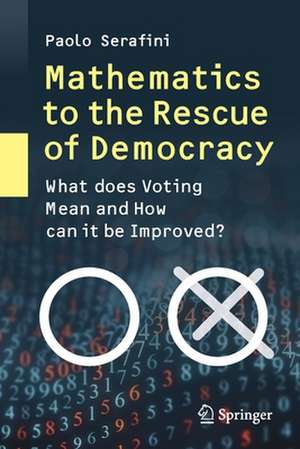Mathematics to the Rescue of Democracy: What does Voting Mean and How can it be Improved?
Autor Paolo Serafinien Limba Engleză Paperback – 3 mar 2020
Preț: 176.37 lei
Nou
Puncte Express: 265
Preț estimativ în valută:
33.78€ • 34.80$ • 28.30£
33.78€ • 34.80$ • 28.30£
Carte disponibilă
Livrare economică 03-17 februarie
Livrare express 17-23 ianuarie pentru 39.78 lei
Preluare comenzi: 021 569.72.76
Specificații
ISBN-13: 9783030383671
ISBN-10: 3030383679
Pagini: 135
Ilustrații: XIII, 135 p. 12 illus., 2 illus. in color.
Dimensiuni: 155 x 235 x 8 mm
Greutate: 0.22 kg
Ediția:1st ed. 2020
Editura: Springer International Publishing
Colecția Springer
Locul publicării:Cham, Switzerland
ISBN-10: 3030383679
Pagini: 135
Ilustrații: XIII, 135 p. 12 illus., 2 illus. in color.
Dimensiuni: 155 x 235 x 8 mm
Greutate: 0.22 kg
Ediția:1st ed. 2020
Editura: Springer International Publishing
Colecția Springer
Locul publicării:Cham, Switzerland
Cuprins
1. Voting.- 2 Aggregating different evaluations into a unique evaluation.- 3 Condorcet.- 4 Borda.- 5 Simple majority and run-off voting.- 6 Impossible wishes.- 7 Majority Judgement.- 8 Legislative territorial representation.- 9 The United States Congress.- 10 Legislative political representation.- 11 Biproportional representation.- 12 Political districting.- 13 Some additional considerations (and personal).- References.- Index.
Recenzii
“Paolo Serafini has the merit of presenting in a synthetic and pedagogical way the main aspects of the voting theory. This book would be well suited for undergraduate and graduate students who are new to voting theory … . the book is very enjoyable to read … . The present book adds its stone to the series of books on voting theory while distinguishing itself by its pedagogy and simplicity.” (Eric Kamwa, Journal of Economics, Vol. 134, 2021)
“This book exposes a variety of social choice systems … . The electoral rules for the formation of the government of several countries are discussed, as examples of application of different aggregation methods, their particular problems and shortcomings are highlighted and opportunities of improvement underlined.” (Annibal Parracho Sant’Anna, zbMATH 1476.91002, 2022)Notă biografică
Paolo Serafini was Professor of Operations Research in the Department of Mathematics, Computer Science, and Physics, University of Udine, Italy for more than 25 years until his retirement in 2016. After the degree in Electronic Engineering, he worked for a few years at FIAT, Grandi Motori, Turin. He joined the Faculty of Sciences, University of Udine, in 1978 where he became Associate Professor in 1985 and Full Professor in 1990. In the academic year 1995-96, he was Visiting Professor at Carnegie Mellon University, Pittsburgh, and in 1980, he was Visiting Researcher at the University of California, Berkeley. He has been a researcher at the International Center for Mechanical Sciences (CISM), Udine since 1975 and was appointed Scientific Editor of the CISM–Springer Lecture Notes series in 2005. His scientific interests have dealt mainly with the development of mathematical models for resource optimization and, in recent years, with the mathematics of electoral systems as well. He is the author of about 80 papers and four books and has also edited six books.
Textul de pe ultima copertă
This book explains, in a straightforward way, the foundations upon which electoral techniques are based in order to shed new light on what we actually do when we vote. The intention is to highlight the fact that no matter how an electoral system has been designed, and regardless of the intentions of those who devised the system, there will be goals that are impossible to achieve but also opportunities for improving the situation in an informed way. While detailed descriptions of electoral systems are not provided, many references are made to current or past situations, both as examples and to underline particular problems and shortcomings. In addition, a new voting method that avoids the many paradoxes of voting theory is described in detail. While some knowledge of mathematics is required in order to gain the most from the book, every effort has been made to ensure that the subject matter is easily accessible for non-mathematicians, too. In short, this is a book for anyone who wants to understand the meaning of voting.
Caracteristici
Sheds new light on the meaning of voting Highlights the shortcomings of electoral systems and opportunities for improvement Describes a new voting method that avoids the paradoxes of voting theory Employs mathematics in a readily accessible way
